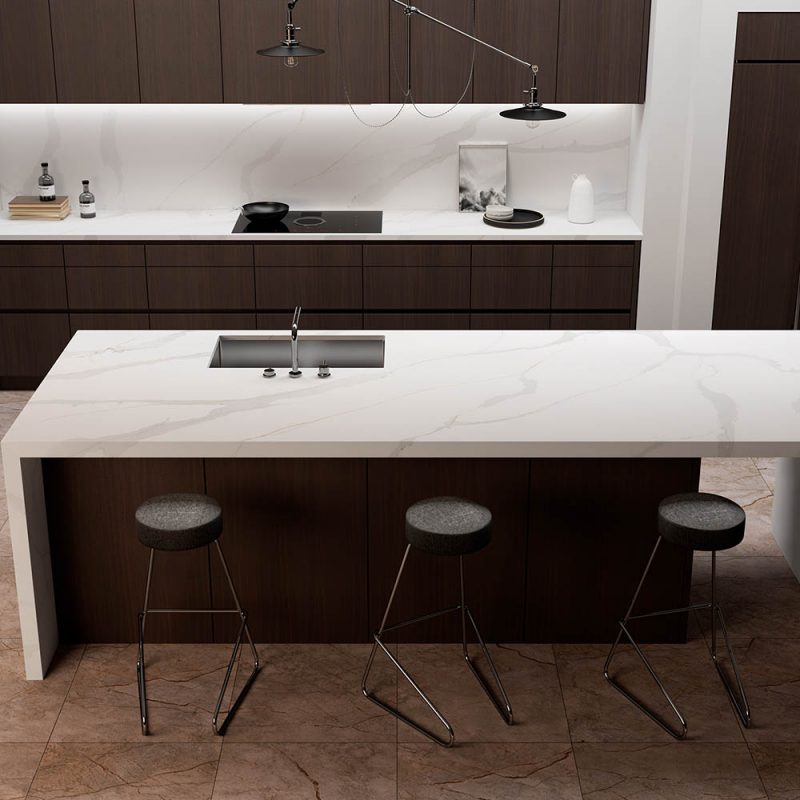Calacatta marble countertops have gained immense popularity in the world of interior design. With their stunning appearance and luxurious feel, Calacatta marble countertops have become a sought-after choice for homeowners and designers alike. However, before investing in this beautiful natural stone, it’s essential to have a thorough understanding of its characteristics, maintenance requirements, and suitability for your specific needs. In this article, we will answer some frequently asked questions about Calacatta marble countertops, providing you with the knowledge and confidence to make an informed decision.

This article interest may you. Which kitchen countertop to choose?
Calacatta Marble Countertops: Frequently Asked Questions
1. What is Calacatta marble?
Calacatta marble is a type of natural stone renowned for its white background and striking veins of gray and gold. It is quarried in the Carrara region of Italy and is widely considered to be one of the most luxurious and coveted marbles in the world. Calacatta marble is often used in high-end residential and commercial projects due to its elegant appearance and timeless appeal.
2. How is Calacatta marble different from Carrara marble?
While both Calacatta and Carrara marble originate from the same region in Italy, they have distinct differences. Calacatta marble tends to have a whiter background with more pronounced and dramatic veining, whereas Carrara marble features a softer grayish background with subtle veins. Calacatta marble is generally considered to be rarer and more luxurious than Carrara marble.
3. What are the advantages of Calacatta marble countertops?
Calacatta marble countertops offer several advantages that contribute to their popularity:
- Luxurious Aesthetic: Calacatta marble’s elegant and sophisticated appearance adds a touch of luxury to any space, making it a highly desirable choice for countertops.
- Variety of Veining: The unique veining patterns of Calacatta marble ensure that each slab is one-of-a-kind, allowing for a truly distinctive countertop design.
- Increased Home Value: Installing Calacatta marble countertops can significantly enhance the value and appeal of your home, attracting potential buyers or tenants.
- Heat Resistance: Calacatta marble has excellent heat resistance, making it suitable for use in kitchens and areas where hot objects are frequently placed.
- Durability: Although marble is a softer stone compared to granite, Calacatta marble is still durable enough to withstand normal kitchen activities when properly cared for.
4. Are Calacatta marble countertops prone to staining?
Due to its porous nature, Calacatta marble countertops can be susceptible to staining if not properly sealed and maintained. It is essential to use a high-quality sealer specifically designed for natural stone countertops to create a protective barrier against stains. Regular resealing is also recommended to maintain the longevity and beauty of Calacatta marble countertops.
5. How should Calacatta marble countertops be cleaned and maintained?
To ensure the longevity and pristine appearance of Calacatta marble countertops, follow these cleaning and maintenance tips:
- Daily Cleaning: Wipe the surface with a soft, damp cloth or sponge to remove any spills or crumbs. Avoid using abrasive cleaners or scrub brushes that can scratch the marble.
- Avoid Harsh Chemicals: Steer clear of acidic or abrasive cleaners that can etch or damage the marble surface. Instead, use pH-neutral cleaners specifically formulated for marble.
- Prompt Spill Cleanup: Clean up any spills immediately to prevent staining. Blot the spill with a soft cloth rather than wiping it to avoid spreading the liquid.
- Regular Sealing: Reapply a high-quality stone sealer every 6 to 12 months to maintain a protective barrier against stains and etching.
- Use Coasters and Trivets: Place coasters under glasses and trivets under hot cookware to protect the marble from potential damage caused by heat or moisture.
6. Can Calacatta marble countertops be used in the bathroom?
Yes, Calacatta marble countertops are an excellent choice for bathroom vanities. The elegant and luxurious appearance of Calacatta marble can elevate the overall aesthetic of your bathroom, creating a spa-like atmosphere. However, it’s important to note that marble is more susceptible to etching and staining in a bathroom environment due to the use of certain beauty and cleaning products. Proper sealing and regular maintenance are crucial to protect the marble surface.
7. How does the cost of Calacatta marble compare to other countertop materials?
Calacatta marble is considered a premium material, and as such, it is more expensive than many other countertop options. The rarity, quality, and unique veining patterns contribute to its higher price point. However, it’s important to remember that investing in Calacatta marble countertops adds significant value to your home and creates a timeless and luxurious ambiance that is hard to replicate with other materials.
8. Can scratches on Calacatta marble countertops be repaired?
Minor scratches on Calacatta marble countertops can often be remedied using a marble polishing powder or a honing compound. However, deep scratches or chips may require the assistance of a professional stone restoration specialist. It is best to consult with an expert who can assess the damage and recommend the most appropriate course of action.
9. Are there any alternatives to Calacatta marble countertops?
If the cost or maintenance requirements of Calacatta marble countertops are not suitable for your needs, there are alternative materials that can mimic the look of Calacatta marble:
- Quartz: Engineered quartz countertops can replicate the appearance of Calacatta marble while offering greater durability and resistance to staining.
- Porcelain: Porcelain countertops can imitate the look of Calacatta marble with remarkable accuracy. They are non-porous, making them highly resistant to stains and scratches.
- Granite: Some types of granite feature veining patterns similar to Calacatta marble, providing an alternative natural stone option with increased durability.
Calacatta marble is not recommended for outdoor applications. Exposure to harsh weather conditions, UV rays, and fluctuations in temperature can cause the marble to deteriorate and lose its luster over time. Additionally, the high porosity of marble makes it susceptible to water penetration and staining, further compromising its durability. It is best to reserve Calacatta marble for indoor use where it can be protected from the elements.
11. Are there different grades of Calacatta marble?
Yes, Calacatta marble is available in different grades based on the quality and appearance of the stone. The highest grade of Calacatta marble is known as “Calacatta Oro” or “Calacatta Gold,” characterized by its white background and bold gold veining. This grade is highly sought after and often used in luxury applications. Lower grades may have more gray veining or variations in the color and intensity of the veining.
12. Can Calacatta marble countertops be honed?
Yes, Calacatta marble countertops can be honed to achieve a matte or satin finish. Honing involves grinding the surface of the marble to remove the polished finish, resulting in a smooth and velvety texture. Honed Calacatta marble countertops are a popular choice for those who prefer a more understated and less reflective surface.
13. How do I protect Calacatta marble from etching?
Calacatta marble is susceptible to etching, which occurs when acidic substances come into contact with the marble surface, causing a dull and rough appearance. To protect your Calacatta marble countertops from etching:
- Wipe up acidic spills (such as lemon juice, vinegar, or wine) immediately to prevent prolonged contact with the marble.
- Use cutting boards and trivets to protect the marble from direct contact with acidic foods or hot cookware.
- Avoid using acidic or abrasive cleaners that can etch the marble. Stick to pH-neutral cleaners specifically formulated for marble.
14. Can I install Calacatta marble countertops myself?
While it is possible to install Calacatta marble countertops yourself, it is a complex and demanding process that requires specialized tools and expertise. Improper installation can result in damage to the countertops or a subpar finished product. It is highly recommended to hire a professional countertop installer with experience working with natural stone to ensure a proper and precise installation.
15. Can Calacatta marble be used in a contemporary or modern kitchen?
Absolutely! Calacatta marble’s timeless beauty and versatility make it an excellent choice for contemporary or modern kitchen designs. The contrast between the white background and the bold veining adds a touch of drama and visual interest to the space. Pairing Calacatta marble countertops with sleek, minimalist cabinetry and stainless steel appliances can create a stunning contemporary aesthetic.
16. How do I find a reputable supplier of Calacatta marble countertops?
Finding a reputable supplier is crucial to ensure that you receive high-quality Calacatta marble countertops. Here are a few tips to help you find a reliable supplier:
- Research and read reviews: Look for suppliers with positive reviews and a good reputation in the industry. Check online platforms, forums, or social media groups for customer feedback and experiences.
- Visit showrooms: If possible, visit showrooms or stone yards to see the Calacatta marble slabs in person. This allows you to inspect the quality and select the exact slab you desire.
- Ask for certifications: Inquire about the supplier’s certifications and affiliations. Reputable suppliers often adhere to industry standards and can provide documentation to ensure the authenticity and quality of their products.
- Seek recommendations: Ask for recommendations from friends, family, or professionals in the industry who have experience working with Calacatta marble countertops.
17. Can I use Calacatta marble for backsplashes?
Yes, Calacatta marble can be used for backsplashes to create a cohesive and elegant look in your kitchen or bathroom. Using the same material for both countertops and backsplashes can provide a seamless and visually appealing design. However, it’s important to consider the maintenance requirements and potential exposure to moisture and splashes. Proper sealing and regular maintenance are essential to protect the marble from staining and etching.
18. Can Calacatta marble be repaired if it gets damaged?
Minor chips or small areas of damage on Calacatta marble countertops can often be repaired by a professional stone restoration specialist. They can fill in the damaged area with color-matched epoxy or perform a process called “invisible mending” to blend the repaired section with the rest of the countertop. It is recommended to consult with an expert to assess the damage and determine the most appropriate repair method.
19. Can I use harsh cleaners on Calacatta marble countertops to remove tough stains?
No, it is not advisable to use harsh or abrasive cleaners on Calacatta marble countertops. Harsh cleaners can etch the marble surface, causing permanent damage. Instead, opt for gentle and pH-neutral cleaners specifically formulated for marble. For tough stains, create a poultice by mixing a mild detergent with baking soda or talcum powder, apply it to the stain, and let it sit overnight. Rinse and gently clean the area the next day, and repeat if necessary.
20. Can I place hot pans directly on Calacatta marble countertops?
While Calacatta marble is heat-resistant, it is still best to use trivets or hot pads to protect the surface from direct contact with hot cookware. Sudden temperature changes or prolonged exposure to extreme heat can potentially cause thermal shock and damage the marble. Taking precautions and using heat-resistant materials will help maintain the integrity and beauty of your Calacatta marble countertops.
21. Can I install Calacatta marble countertops in a high-traffic area?
Calacatta marble countertops can be installed in high-traffic areas, but it’s important to consider their unique characteristics. Being a natural stone, marble is softer and more susceptible to scratching and etching compared to some other countertop materials. In high-traffic areas, take extra care to use cutting boards, coasters, and trivets to protect the surface. Regular cleaning and maintenance will also help preserve the beauty and durability of your Calacatta marble countertops.
22. What is the lifespan of Calacatta marble countertops?
With proper care and maintenance, Calacatta marble countertops can last a lifetime. However, it’s important to note that marble is a natural material and will develop a patina over time. The appearance of the marble may change as it develops a natural weathering process known as “character.” This aging process can add to the charm and uniqueness of the stone. By following the recommended cleaning and maintenance practices, you can ensure that your Calacatta marble countertops retain their beauty and durability for years to come.
23. Can I use Calacatta marble for fireplace surrounds?
Yes, Calacatta marble is an excellent choice for fireplace surrounds. Its luxurious and timeless appeal adds elegance to any fireplace design. However, it’s essential to take into consideration the exposure to heat and potential staining from soot or smoke. Regular cleaning and sealing will help protect the marble surface and maintain its pristine appearance.
24. Can I use acidic cleaners on Calacatta marble to remove hard water stains?
No, acidic cleaners should not be used on Calacatta marble to remove hard water stains. Acidic cleaners can etch and damage the marble surface. Instead, use a mixture of mild detergent and warm water to gently clean the area. If hard water stains persist, you can create a poultice using baking soda and water. Apply the poultice to the stain, let it sit for a few hours, and then gently clean the area. Repeat if necessary.
25. How often should Calacatta marble countertops be sealed?
Calacatta marble countertops should be sealed upon installation and then resealed periodically according to the manufacturer’s recommendations. The frequency of sealing depends on factors such as the type of sealer used, the level of use and exposure, and the porosity of the marble. On average, it is recommended to reseal Calacatta marble countertops every 6 to 12 months. Regular sealing helps to protect the surface from stains and etching, keeping your countertops looking beautiful for longer.
Conclusion
Calacatta marble countertops offer a luxurious and timeless aesthetic to any space. With their distinct white background and striking veining patterns, they are a popular choice for homeowners and designers seeking elegance and sophistication. However, it is important to understand the characteristics and maintenance requirements of Calacatta marble to ensure its longevity and beauty.
By following proper care and maintenance practices, such as using cutting boards, coasters, and trivets, and cleaning with gentle, pH-neutral cleaners, you can protect your Calacatta marble countertops from damage. Regular sealing and periodic professional maintenance will also help preserve their pristine appearance.
While Calacatta marble is a premium material with a higher price point, its value extends beyond its cost. It adds a touch of luxury to your home and can significantly enhance its overall appeal and value. Whether in the kitchen, bathroom, or other living spaces, Calacatta marble countertops create a statement that is hard to replicate with other materials.
So, if you’re considering Calacatta marble countertops for your next project, take the time to explore its beauty, consult with professionals, and make an informed decision. Embrace the elegance and timelessness that Calacatta marble brings to your space, and enjoy the enduring beauty for years to come.

